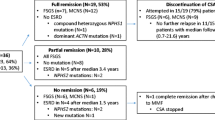Abstract
Steroid-resistant (SR) forms of nephrotic syndrome (NS) have a poorer outcome in blacks compared to other racial groups. In this study, 223 children with SRNS, aged 1–16 years old, were analysed retrospectively for the period 1976–2004. Treatment schedules included oral cyclophosphamide (2–3 mg/kg) with prednisone 0.5–1 mg/kg (maximum 60 mg) only (n=90); prednisone on alternate days with methylprednisolone (30 mg/kg, maximum 1 g) and oral cyclophosphamide (n=117); oral prednisone on alternate days, three doses of intravenous methylprednisolone on alternate days and monthly doses of intravenous cyclophosphamide (500–750 mg m−2 dose−1×7 doses monthly) (n=10); or cyclosporine 5 mg kg−1 day−1 adjusted to a trough level of 150–200 mg/ml (n=6). We compared the clinical and biochemical characteristics and outcome using different forms of therapies. A total of 183 (82.1%) underwent biopsy; 84 (45.9%) were Indian and 99 (54.1%) were black. Sixty-six (36.1%) had minimal change NS, 66 (36.1%) had focal segmental glomerulosclerosis (FSGS), 15 (8.2%) had a proliferative form of NS, and 36 (19.7%) had other forms of NS. Of the 84 Indian children biopsied, 58 (69.0%) were in complete remission, including 29 of 40 (72.5%) treated with oral cyclophosphamide and prednisone only. Of the 99 black children who were biopsied, 20 (20.2%) achieved complete remission; none of those treated with oral cyclophosphamide and prednisone only achieved complete remission. Of the 40 Indian children who were not biopsied who received only oral prednisone and cyclophosphamide, 32 (80%) achieved complete remission. This study shows Indian children with SRNS respond better to treatment than black children (69.0 vs. 20.2%). Since 80% of Indian children with SRNS responded to a trial of oral cyclophosphamide and prednisone, we propose the use of oral cyclophosphamide therapy in non-black children before embarking on renal biopsy.

Similar content being viewed by others
References
Bhimma R, Coovadia HM, Adhikari M (1997) Nephrotic syndrome in South African children: changing perspectives over 20 years. Pediatr Nephrol 11:429–434
Bhimma R, Coovadia HM, Adhikari M Connolly CA (2003) The impact of the hepatitis B virus vaccine on the incidence of hepatitis B virus-associated membranous nephropathy. Arch Pediatr Adolesc Med 157:1025–1030
Barratt TM, Beattie JM, Coleman J (1994) Consensus statement of management and audit potential to steroid responsive nephrotic syndrome. Arch Dis Child 70:151–157
Bernstein J (1995) Histopathology of the idiopathic nephrotic syndrome. Systemic disorders. In: Strauss J (ed) Paediatric nephrology in perspective. University of Miami Press, Coral Gables, FL, pp 163–172
Adhikari M (1981) The nephrotic syndrome in African and Indian children in South Africa. PhD thesis, University of Natal, Durban, South Africa
Counahan R, Chantler C, Chozali S, Kirkwood B, Rose F, Barrat TM (1976) Estimation of glomerular filtration rate from the plasma creatinine in children. Arch Dis Child 51:875–878
National Kidney foundation (2002) K/DOQI clinical practice guidelines for chronic kidney disease: evaluation, classification, and stratification. Am J Kidney Dis 39(Suppl 1):S1–S266
Pesce MA, Strande CS (1973) A new micro method for determination of protein in cerebrospinal fluid and urine. Clin Chem 19:1265–1267
Husdan H, Rappoport A (1968) Estimation of creatinine by the Jaffe reaction: comparison of three methods. Clin Chem 14:222–238
Felix MB, Cesar P, Dajani T, Ferris M, Swinford RD, Portman RJ, Verani R (1999) Changing patterns in the histopathology of idiopathic nephrotic syndrome in children. Kidney Int 55:1885–1890
Mendoza SA, Reznik VM, Grisworld WR, Krensky AM, Yorgin PD, Tune BM (1990) Treatment of steroid-resistant focal segmental glomerulosclerosis with pulse methylprednisolone and alkylating agents. Pediatr Nephrol 4:303–307
Adhikari M, Bhimma R (1997) Comparisons of two different forms of focal segmental glomerulosclerosis. Pediatr Nephrol 11:423–428
Tune BM, Mendoza SA (1997) Treatment of the idiopathic nephrotic syndrome: Regimens and outcomes in children and adults. J Am Soc Nephrol 8:824–832
Baqi N, Singh A, Balachandra S, Ahmad H, Nicastri A, Kytinski S, Homel P, Tejani A (1998) The paucity of minimal change disease in adolescents with primary nephrotic syndrome. Pediatr Nephrol 12:105–107
Tarshish P, Tobin JN, Bernstein J, Edelman CM (1996) Cyclophosphamide does not benefit with focal segmental glomerulosclerosis. A report of the International Study of Kidney Disease in Children. Pediatr Nephrol 10:590–593
Bagga A, Mantan M (2005) Nephrotic syndrome in children. Indian J Med Res 122:13–28
Ichikawa I, Fogo A (1996) Focal segmental glomerulosclerosis. Pediatr Nephrol 10:374–391
Braden GL, Mulherm JG, O’Shea MH, Nash SV, Ucci AA, Germain MS (2000) Changing incidence of glomerular diseases in adults. Am J Kidney Dis 35:878–883
Kim JS, Belleu CA, Silverstein DM, Aviles DH, Boineau FG, Vehaskari VM (2005) High incidence of initial and late steroid resistance in childhood nephrotic syndrome. Kidney Int 68:1275–1281
Waldo FB, Benefield MR, Kohaut EC (1992) Methylprednisolone treatment ofpatients with steroid-resistant nephrotic syndrome. Pediatr Nephrol 6: 503–505
Elhence R, Gulati S, Kher V, Gupta A, Sharma RK (1994) Intravenous pulse cyclophosphamide-a new regime for steroid-resistant minimal change nephrotic syndrome. Pediatr Nephrol 8:1–3
Rennert WP, Kala UK, Jacobs D, Goetsch S, Verhaart S (1999) Pulse cyclophosphamide for steroid-resistant focal segmental glomerulosclerosis. Pediatr Nephrol 13:113–11651
Tune BM, Kirpekar R, Sibley RF, Reznik VM, Griswold WR, Mendoza SA (1995) Intravenous methylprednisolone and oral alkylating agent therapy of prednisone-resistant paediatric focal glomerulosclerosis: a long-term follow-up. Clin Nephrol 43:84
Acknowledgements
The authors wish to thank the Medical Manager of King Edward VIII Hospital for permission to publish this paper, Ms. Cathy Connolly for her assistance with the statistics, Dr. Craig B. Langman from The Children’s Memorial Hospital in Chicago for his comments and Ms. S. Rambali for her secretarial assistance.
We are grateful to the Medical Research Council (SA) and the National Kidney foundation (SA) for their financial support.
Author information
Authors and Affiliations
Corresponding author
Rights and permissions
About this article
Cite this article
Bhimma, R., Adhikari, M. & Asharam, K. Steroid-resistant nephrotic syndrome: the influence of race on cyclophosphamide sensitivity. Pediatr Nephrol 21, 1847–1853 (2006). https://doi.org/10.1007/s00467-006-0276-2
Received:
Revised:
Accepted:
Published:
Issue Date:
DOI: https://doi.org/10.1007/s00467-006-0276-2




